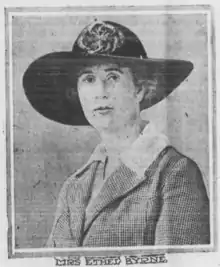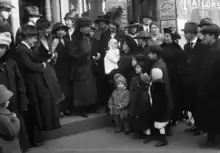
Ethel Byrne (née Higgins; 1883–1955) was an American Progressive Era radical feminist. She was the younger sister of birth control activist Margaret Sanger, and assisted her in this work.
Background
Ethel and Margaret were two out of eleven children of an Irish American family founded by Michael Hennessey Higgins and Anne Higgins.[1] It has been noted that Anne Higgins gave preferential treatment to Ethel, much to the dismay of Margaret, and that caused a rift in their relationship.[2]
Ethel had a short and unhappy marriage to Jack Byrne, a glassworker.[3] They had two children, Jack and Olive. In 1906, Ethel left her children in the care of their paternal grandparents to protect them from their abusive father;[4] Ethel only visited her daughter once in sixteen years. Olive grew up to become an important muse to the creator of Wonder Woman, William Moulton Marston, and more details of Ethel Byrne's life came to light when Jill Lepore wrote about the superheroine character in 2014.[5]
Ethel Byrne's background in nursing was pivotal to her activism and directly contributed to her desire to make birth control accessible to women of varying socio-economic backgrounds. She was a trained nurse who assisted immigrant women in need of medical care in the Brownsville area of Brooklyn, New York in 1916.[6]
Birth control activism

The two sisters and theatre artist Fania Mindell opened a birth control clinic in Brooklyn in October 1916.[7] The three feminist activists advertised the services offered by the clinic by passing out flyers in different languages, including English, Yiddish and Italian.[8] Although Byrne is not widely known today, her early activism had long lasting impact on raising awareness of the importance of access to information about birth control. The arrest of Ethel Byrne compelled a group of politically active New York women to ask for a meeting with President Woodrow Wilson to request that he contribute to overturning laws criminalizing distribution of birth control.[9]
Arrest and hunger strike
The clinic was highly controversial due to the enforcement of the Comstock Laws. Byrne and Sanger distributed pessaries and would show their clients how to use this method of contraception in direct violation of these laws.[10]
This was the first birth control clinic in the United States.[11] The clinic caused an immediate sensation in the press, getting national attention, and all three women were arrested and tried for "distributing obscene materials".
- "The police monitored the Clinic from its opening and sent in a female undercover agent to purchase contraceptive supplies. On October 26 (1916) an undercover police woman and vice-squad officers raided the clinic, confiscated an assortment of contraceptives from pessaries to condoms, along with 20 'books on young women', and arrested Sanger, Byrne and Mindell. After being arraigned, Sanger and Mindell spent the night in the Raymond Street jail, Byrne at the Liberty Avenue station. All were released the next morning on $500.00 bail."[12]
All three women were found guilty, but eventually the verdicts were overturned, and their campaign was ultimately successful, leading to major changes in social policy and to the laws governing birth control and sex education around the world.[13][14] The clinic closed but later became the basis for what was to become known as Planned Parenthood.
After being arrested for distribution of information about birth control, Byrne was sentenced to 30 days in Blackwell's Island prison.[15] She was jailed at Blackwell Island workhouse on January 22, 1917, for her activism in advocating for the legalization of birth control and subsequently went on a hunger strike.[16] Sanger was concerned her sister would lose her life as a result of this hunger strike and Byrne was force fed while serving her sentence after 185 hours without food or water.[17] As historian Jill Lepore reports in The Secret History of Wonder Woman, Ethel Byrne was the first female political prisoner in the United States to be subjected to force feeding.[18] Mrs. Byrne was prepared to starve herself to death in support of her cause.[19] Her case was the first of a group of cases known as the "Sanger cases" to be brought to trial.[14]
Sanger supported Byrne's activism and was quoted as saying "I didn't advise her to undertake this hunger strike, but I certainly would not tell her to end it now."[20] Although they had a falling out after this arrest, their confinement helped bring national attention to their push for the legalization of birth control.[21] It also hurt their relationship as Sanger's notoriety grew after this arrest and she was sometimes known to take credit for Ethel's infamous hunger strike.
Later years
Although her sister went on to become world-famous for her advocacy of birth control, Byrne's legacy is not well known. This is apparent on the Planned Parenthood website, as it is noted Sanger opened her 1916 clinic with "her sister".[22] Ethel is not even mentioned by name and unlike her older sister is not a household name.
Ethel Byrne had a stroke and died in 1955, aged 71–72. She did not live to see the legalization of the birth control pill, as she died five years before it received FDA approval.[23]
References
- ↑ Lepore, Jill (2014). The Secret History of Wonder Woman. New York: Alfred A. Knopf. p. 81. ISBN 978-0-385-35404-2.
- ↑ Baker, Jean H. (2011). Margaret Sanger: A life of Passion. New York: Hill and Wang. p. 73. ISBN 978-0-80-90-9498-1.
- ↑ Baker, Jean H. (2011). Margaret Sanger: A life of Passion. New York: Hill and Wang. p. 27. ISBN 978-0-80-90-9498-1.
- ↑ Lepore, Jill (2015). The secret history of wonder woman. Vintage. pp. 81–83. ISBN 9780804173407. OCLC 941724731.
- ↑ Lepore, Jill (2014). The Secret History of Wonder Woman. New York: Alfred A. Knopf.
- ↑ Asbell, Bernard (1995). The Pill: A Biography of the Drug That Changed the World. New York: Random House. p. 43. ISBN 0-679-41100-3.
- ↑ "Margaret Sanger is Dead at 82". The New York Times. Retrieved 1 September 2015.
- ↑ "Sanger, Margaret". 21 January 2011.
- ↑ MRS. BYRNE WEAKER, STILL FASTS IN CELL New York Times (1857-1922); Jan 26, 1917; ProQuest Historical Newspapers: The New York Times pg. 1
- ↑ Baker, Jean H. (2011). Margaret Sanger: A Life of Passion. New York: Hill and Wang. p. 116. ISBN 978-0-8090-9498-1.
- ↑ Sullivan, Taylor. "Brownsville Clinic". Margaret Sanger Papers Project. New York University. Retrieved 13 September 2018.
- ↑ Margaret Sanger Papers Project, NYU.
- ↑ “Mrs Sanger Gets 30 Days.” Washington Post, February 7, 1917.
- 1 2 "MRS. SANGER'S AID IS FOUND GUILTY; Mrs. Byrne Convicted on Technicality in First of Birth Control Trials. WOMEN NOISY IN COURT Defendants Bring Before Justices a Mother and Her Six Children as a 'Demonstration'". The New York Times. 9 January 1917. ProQuest 98070877.
- ↑ "Margaret Sanger Papers Project". MSPP. Retrieved 1 September 2015.
- ↑ Dismore, David (22 January 2015). "Today in Herstory: Ethel Byrne Sentenced for Working at a Birth Control Clinic". Feminist Majority Foundation Blog. Feminist Majority Foundation. Retrieved 1 September 2015.
- ↑ "About Sanger". Margaret Sanger Papers Project. MSPP. Retrieved 1 September 2015.
- ↑ Lepore, Jill (2014). The Secret Life of Wonder Woman. New York: Alfred A. Knopf. p. 95. ISBN 978-0-385-35404-2.
- ↑ "MRS. BYRNE NOW FED BY FORCE; Birth-Control Prisoner Near Collapse, Revives After Food Is Administered. OFFERED NO RESISTANCE Mrs. Sanger Hears Her Sister Was in a State of Coma as a Result of Hunger Strike. VISITORS ARE STILL BARRED Blackwell's Island Doctors Not Sure Mrs. Byrne Has Not Had Water During Her 106-Hour Fast. No Resistance Offered. Her Condition Improves. FORCIBLE FEEDING REVIVES MRS. BYRNE Her Lawyer Barred from Island. MRS. SANGER TO STARVE ALSO. Determined to Follow Her Sister's Course if She Is Sentenced". The New York Times. 28 January 1917.
- ↑ Lepore, Jill (2014). The Secret History of Wonder Woman. New York: Alfred A. Knopf. p. 94. ISBN 978-0-385-35404-2.
- ↑ "Margaret Sanger". Center for Disease Control. CDC. Retrieved 1 September 2015.
- ↑ "History & Successes". Planned Parenthood. Archived from the original on 2016-10-03. Retrieved 2015-09-01.
- ↑ Lepore, Jill (2014). The Secret History of Wonder Woman. New York: Alfred A. Knopf. p. 275. ISBN 978-0-385-35404-2.